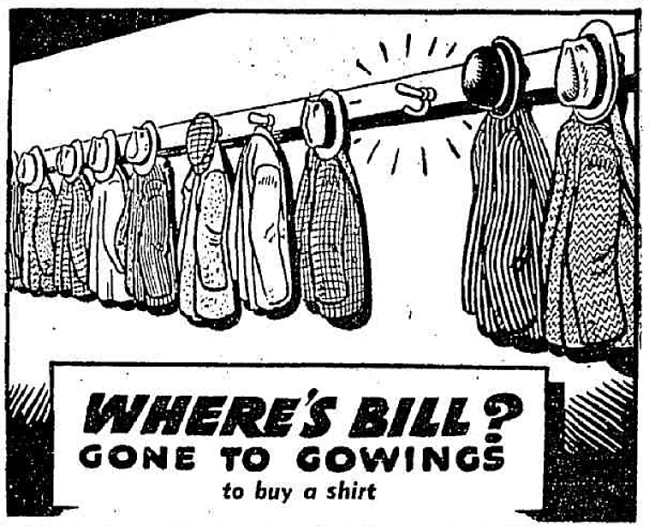In Simile and other evaluative idioms in Australian English, published in Phraseology and Culture in English (Berlin: Mouton de Gruyter, 2007), edited by Paul Skandera, Pam Peters explained the origin and meanings of the Australian-English phrase gone to Gowings (also gone to Gowing’s):
[The] metropolitan idiom, gone to Gowings (referring to a men’s department store in Sydney) is remarkable for its polysemy – or indeterminacy of meaning. The phrase seems to have originated in a series of 1940s advertisements for Gowings, showing scenes vacated in a hurry by those seeking bargains (Wilkes 1995 1). One of these scenarios (a church) focused on the explanatory note “Gone to Gowings” fastened to the altar by the bridegroom who had cut short the wait for his bride. This would account for it becoming a general excuse for someone’s absence, doing something else which cannot or should not be specified. Yet with the elusiveness of its denotation, it has acquired various other applications. In the Macquarie Dictionary (1997) it is associated with “going under” in three different ways: financial deterioration, the failure of a horse or sports team to win, and illness, especially a hangover (from overconsumption of alcohol). Baker (1978: 231 2) reported it as one of the many idioms for drunkenness. Meanwhile in citations obtained from a Google search of Australian internet documents in 2004, gone to Gowings is commonly used to refer to dementia. Both drunkenness and dementia are the focus of other Australian euphemistic paraphrases […], and the pragmatic implications of gone to Gowings, used to cover unexplained absence 3 and / or a dubious condition, have given it a life of its own. Gowings itself continues to trade successfully in everyday clothing, decades after the advertising campaign that made its name a household phrase.
1 A Dictionary of Australian Colloquialisms (Melbourne: Oxford University Press, 1996 [apparently not 1995]), by Gerald Alfred Wilkes (1927-2020)
2 The Australian Language (Milsons Point, N.S.W.: Currawong Press, 1978), by Sidney John Baker (1912-1976)
3 Cf. also origin of the British phrase ‘to go for a burton’
This is the illustration that Pam Peters mentioned—from the advertisement for Gowings published in The Sun (Sydney, New South Wales) of Thursday 4th January 1945:

This is another advertisement for Gowings, published in The Sun (Sydney, New South Wales) of Tuesday 13th August 1946:
WHERE’S BILL?
GONE TO GOWINGS
to buy a shirt
These are the earliest occurrences of the phrase gone to Gowings (also gone to Gowing’s) that I have found, in chronological order:
1-: From the column Sydney Says, by “Smith’s” Diarist, published in Smith’s Weekly (Sydney, New South Wales) of Saturday 16th June 1945:
A CITY fish shop has been closed recently for alterations, and some wag placed a placard in the front of it bearing an advertising slogan now being used extensively by a city firm, reading: “Gone to Gowings.” An unlooked for sequel is that this firm has since had several inquiries relating to the supply of fish.
2-: From the following commercial advertisement, published in The Daily Advertiser (Wagga Wagga, New South Wales) of Thursday 20th December 1945:
No, not gone to Gowing’s, been to “The Watch Doctor” to get my watch repaired for Christmas. Address, 47a Baylis-street (side entrance), opp. Huthwaite’s.
3-: From the Daily Telegraph (Sydney, New South Wales) of Saturday 11th May 1946:
POLE PROVIDES SCOPE FOR STUDENTS’ PRANK
Soon after workmen had erected a pole for floodlights at Sydney University yesterday, a chair was nailed to the top and signs hung up announcing that Professor R. D. Watt would stage a pole-sitting exhibition.
Professor Watt was appointed Professor of Agriculture at the University in 1910.
When the Professor did not appear at the appointed time, students hung a sign “Gone to Gowings” on the pole.
“Chad” was shown, peering over his wall and exclaiming: “What? No Watt! So what?”
Professor Watt was not annoyed at the joke, and said he was chosen only because the pole was erected outside his house.
“I am sure there was nothing personal in the prank,” he said.
“Don’t worry, I have no intention of staging a pole-sitting exhibition.”
George Hammond, who had been sitting on a pole at the corner of George and Campbell Streets since Monday, came down yesterday afternoon, having completed his self-imposed 100-hour vigil.
4-: From the column My Word, by Elizabeth Riddell, published in the Daily Telegraph (Sydney, New South Wales) of Sunday 12th May 1946:
No one will believe this, but just the same it happened.
A policeman was removing a barrow salesman from his barrow, which was parked directly opposite Proud’s in Pitt Street, and edging him along the pavement without too much trouble when the man wrenched himself away, nipped smartly back to the barrow, and wrote in large letters on a large price card, “Gone to Gowing’s.”
5-: From the column Notes from the City, published in The Wingham Chronicle and Manning River Observer (Wingham, New South Wales) of Friday 31st May 1946:
Whoever coined the “Gone to Gowing’s” slogan for the firm’s advts. did better than he ever dreamed, for it has been employed on the stage, and is now in use in all walks of life. As sure as a one-man business posts a notice, “Back in 10 minutes,” someone will write at the top, “Gone to Gowing’s.” Call in on some executive, find his chair vacant, and ask “is he out?” and the invariable reply will be “Yes—gone to Gowing’s.” Even Sydney Uni. boys play up the gag on some of the professrs [sic]—the young ruffians!

